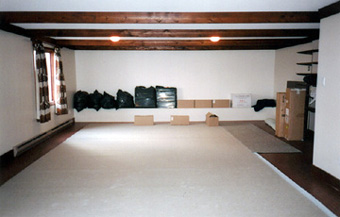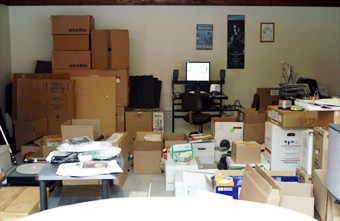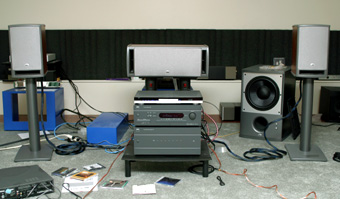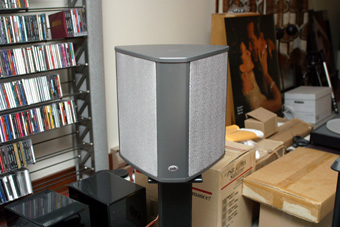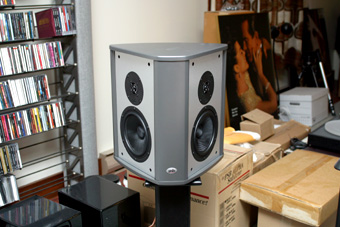![[SoundStage!]](../sslogo3.gif) The Traveler The TravelerBack Issue Article |
|||
May 2005 PSB's Platinum Parade
I’ve come to the conclusion that it takes an audiophile to understand an audiophile. My wife, for example, isn’t an audiophile, although she is an avid music lover. She listens to more music in a day than I do; she just doesn’t care, or at least care all that much, what system she plays it on. For example, she knows that the car system doesn’t sound as good as the downstairs home-theater system, and, in turn, she knows that the downstairs system doesn’t sound as good as the upstairs reference-room system. But that’s not what’s important to her. What’s important is that she can hear her music regardless of the system. As a result, my wife doesn’t walk into my reference room with shock, awe or envy the way most audiophiles would. She walks in and wonders how, in just a few short months, I took a spacious, wide-open room and turned it into an absolute mess. On the other hand, Paul Barton, probably Canada’s most well-known and well-respected speaker designer, is an audiophile and a music lover. He’s been designing speakers since before I could turn a power button on, and he’s been listening to and playing music for longer than I’ve been alive. When Paul walked into my listening room this spring, he didn’t see a mess. He saw a sanctuary. Paul is an audiophile. Take, for example, the boxes I have "stored" in the back half of my room. My wife sees a cluttered and unsightly jumble of confusion, the result of my own laziness to take them all downstairs and put them neatly in the crawlspace under the house. Paul, on the other hand, doesn't see it the same way. Instead, he sees those boxes as "diffusers" and "absorbers" that add significantly to the sound of the room. Without them this enormous room might be somewhat barren and "echoey" -- a concern for audiophiles who put the sound of their systems above all else. Those boxes, along with the stacks of paper and other materials, provide just the right amount absorption and diffusion, making not for an unsightly mess, but rather for an ideal listening environment. And their placement Paul didn’t see as haphazard and unsightly; instead, he surmised that their "randomness" wasn’t a result of laziness, but, rather, a strategic effort to ensure that the sound waves traveling past the listener and into the back end of the room would be scattered here and there, resulting in a far better acoustical environment than if they were more symmetrical or, God forbid, were not there at all. "These boxes are perfect," Paul proclaimed. "You shouldn’t get rid of them." Hearing that, from Paul Barton, of all people, was the kind of ammo I needed. "Did you hear that, Honey?" I yelled out the doorway, hoping my voice would carry all the way down the stairs to where she was. "Paul says all these boxes are perfect in my room. I can’t get rid of them." Indeed, my wife did hear my voice. She stood listening in our just-renovated kitchen, amidst the brand-new stainless-steel appliances that she does "ooh" and "ahh" over. She was, however, unconvinced, despite Paul's expertise. As I said, it takes an audiophile to understand an audiophile. With Paul’s blessing of my room, he was now more than prepared to unload the contents of his van into it. After all, he didn’t want his creations to go just anywhere. He needed to ensure that the environment they’d be played in would be suitable for what he feels are the very best speakers he’s ever made -- the Platinum series from PSB.
My goal for inviting Paul to my new home was to expand my scope from the Platinum M2 stand-mounted speakers I reviewed as a stereo pair in December of last year to a full-blown Platinum-based multichannel system. I would use the M2s as front speakers ($1999 USD per pair without stands); a C2 center-channel speaker ($1499), which is smallest center-channel in PSB’s Platinum lineup (the $1999 C4 is the largest); and the S2 "Tri-Mode" surround speakers ($2399 per pair), which are highly versatile due to the configuration options for them (see below). Of course, no multichannel system these days would be complete without a subwoofer. And when it comes to subwoofing these days, it seems that bigger is always better. Together, Paul and I hauled in the massive Platinum S10 subwoofer ($2499) that features two 12" woofers in one heck of a sturdily built cabinet. It's huge. Of course, with all these speakers you need the electronics to make them work. Luckily, Paul had that covered, too. Due to the fact that PSB and NAD are both owned by Lenbrook, Paul also brought along with him an NAD T 973 seven-channel power amplifier (rated at 140Wpc with all channels driven, priced at $1999) and an NAD T 163 7.1-channel preamplifier-processor ($1499). These are both sizeable, well-built, reasonably hefty units, but they still share NAD’s long-time philosophy of simplicity and high value. If you notice, I made deliberate mention that the T 973 delivers seven channels of power and that the T 163 is 7.1-channel capable (the .1 being the subwoofer, of course). Keen readers might wonder why seven matters all that much because I only mentioned five speakers and the subwoofer. Well, in reality Paul actually brought me seven speakers and the subwoofer. Well, kind of, anyway. Let me explain. As Paul left that evening, he gave me some final instructions. I remember that he specifically said for me to "read the owner’s manual to configure the S2s properly" in my room. I confess, though, that I looked at him sort of oddly and wondered why he was telling me this. After all, on the back of the S2s are two sets of binding posts -- nothing complicated at all -- and I did what I suspect many people would: hook up a pair of speaker cables to one set and run jumpers to the next and say "That’s that." An owner’s manual? What audiophile needs that?
Little did I know, at least right off the bat, that the S2s are, in fact, configurable three different ways, hence the Tri-Mode designation that PSB gives them. To understand it all fully, though, you don’t just have to read the owner’s manual; you have to snap off the grilles, too, and have a closer look. When you take the S2s' grilles off you’ll see two sides each containing two sets of drivers -- two woofers and two tweeters for each speaker. By default, if you plug a single set of speaker cables in the back, as I did, and run the jumpers from one set of binding posts to the other, the S2 will act as a "bipolar" radiator, meaning that both tweeters and woofers will operate in phase. By reconfiguring the jumpers, though, you make the S2 act as a "dipole," meaning that one side is out of phase with the other. People sometimes prefer dipoles for their "spaciousness" over direct radiators, or even bipoles (this will depend on the material, the owner's listening preferences, and, of course, the room). Finally, if you’re ambitious enough to run two sets of speaker cables to each S2 and use no jumpers, you can configure each S2 as two speakers -- one side of drivers is one channel and the other side is another channel. This means that the system I have can be a five-channel system plus subwoofer with the S2s operating as either bipole or dipole radiators, or a seven-channel system plus subwoofer where each side of the S2 acts as separate speaker. Very cool, not to mention versatile, too. No wonder Paul wanted me to read up and experiment accordingly. Finally, the only thing Paul didn’t leave me was a digital player of some sort. Luckily, I was scheduled to review Harman Kardon’s DVD 31, which supports DVD-Audio, DVD-Video, CD, and most other modern music formats (except SACD). In fact, the review of the DVD 31 appears in the "OnHiFi" section of SoundStage! A/V this month, so you can read about this high-value piece there. The DVD 31 isn’t the only high-value piece in this system, though. Although the Platinum speakers are PSB’s best and, subsequently, most expensive speakers, they’re still quite reasonably priced considering how well they’re made, how striking they look, and how impressively they perform. The same can be said for the NAD gear. It offers true high-end multichannel sound at a still-sane asking price. As with the DVD 31, you’ll be reading about the PSB Platinum speakers and the NAD electronics on SoundStage! A/V in the months to come. ...Doug Schneider
|
|||
|
|||
![[SoundStage!]](../sslogo3.gif) All Contents All ContentsCopyright © 2005 SoundStage! All Rights Reserved |
